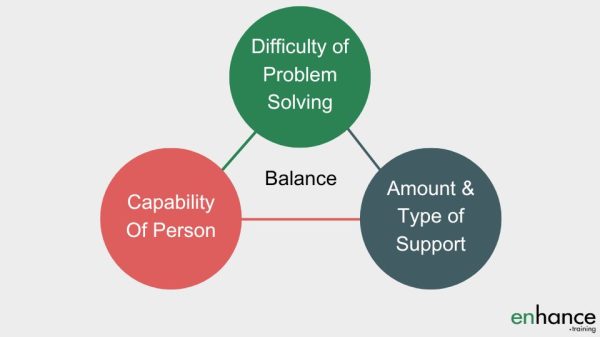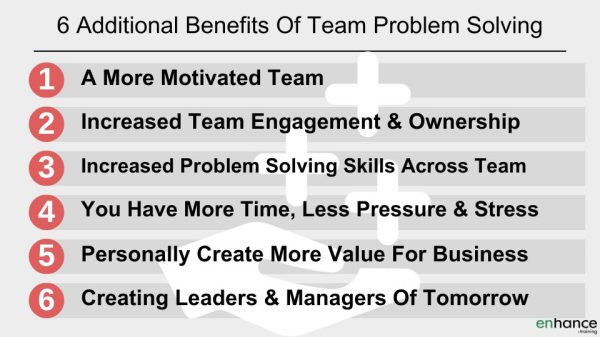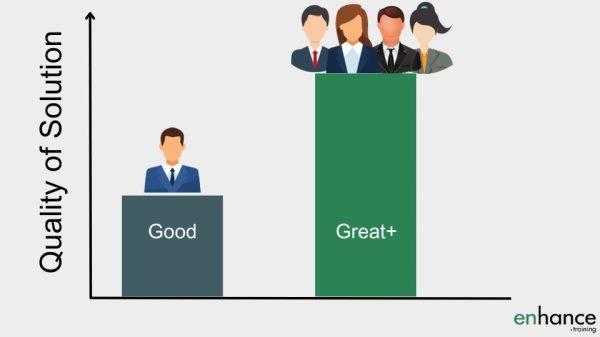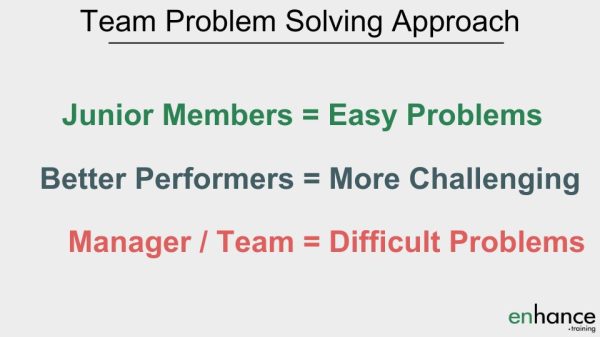Title

Success is getting your employees thinking. For any manager, the more your employees can help you do your job, the better off you will be, the company will be, and your employees will be. A serious win-win-win in my opinion.
Get your employees thinking to create more value through the team. Managers should not be hung up on themselves being the focal point of ideas, decisions, solutions, and the critical thinking. High performing teams utilise all the resources they have available which includes all the brainpower and ideas of team members. I have seen time and time again that many minds create better solutions than one mind. Differences of opinions, backgrounds, experiences and thinking processes create better solutions when harnessed in the right way.
Success is Getting Your Employees Thinking
- Why you should get your employees thinking
- 3 key ways to get your team members thinking
- When to assign problems not tasks at work
When the team is doing well, the manager of that team does well. I can’t remember a time in over 20 years when the manager gets promoted despite the team is not doing well. The teams’ success is the manager’s success.
You can make your team a lot more successful when you get them all thinking and contributing their best to the team’s success.
How do you get your team thinking is the big question, which we cover shortly.
Watch on YouTube
Listen on Podcast
In case you are not sold yet, or you are scared that a team doing more of your job will mean less job security for you, I am taking you through
why you should get your employees thinking
I absolutely love it when my team members think and solve problems themselves without reference to me. It makes my job as a manager so much easier. Here’s why.
Not all problems are the same. For instance, you get problems that:
- Repeatedly occur with minor differences, for which you can apply a similar solution or
- Problems that occur regularly with larger differences, which require more bespoke solutions within a framework known to solve these problems
- All the way through to new problem, that hasn’t occurred before and hasn’t been solved within the team or business before, which requires critical thinking to solve
If you, the manager, spend most of your time solving the easier problems, then you will probably never get round to solving the tough problems because you won’t have the mental time and space needed. Being in this situation means you won’t be creating as much value for the business which means slower career progress if any.

A Better Approach
A much better approach is getting the junior team members to solve the continually occurring simple problems, your better performers to solve regular by not straight forward problems and you keep yourself available to solve the one-off tough problems.
This approach maximizes the problem-solving capability across the team, making best use of the respective experience and skills of the team members, which in turn means much better team performance.
You also get:
- A more motivated team
- The team being more engaged and taking more ownership
- A team increasing their problem solving skills and confidence, which further increases team performance
- You have more time, less pressure, less stress and are perceived as a better manager
- You personally create a lot more value for the business directly and through your team
- In addition you are helping to create leaders and managers of the future, creating the capability in the team so you can continue to grow your skills and experience and thus move your career forward too.
What is not to like. Please think about and try to overcome any fears and insecurities you may have about empowering your team. Counter-intuitively, your job security will go up not down because you get your employees to think more. You become a lot more valuable as a manager to the business when you create mini-managers in your team.
Start small and build once you see and feel the benefits personally of getting your employees thinking!

3 key ways to get your employees thinking
I remember having people queued up at my desk to ask me to make decisions and solve their problems. It felt really good. All these team members thought my opinion was valuable. Great for my ego, not so good for encouraging improved team performance. Every spare minute of my time was spent helping others sort out their problems. I was the team bottleneck.
It didn’t take me that long to realise that maybe I was creating problems for myself. Here are some of the things I did about it.
Firstly, whenever a team member asked me for my opinion or a decision, I would ask a question back to them. “What do you think? How would you solve this? What options are best to take do you think?” Ask questions – then stay silent until they provided at least one solution or decision.
Improve this further by asking team members to come with a solution to every problem they spot.
Secondly, wherever possible, I would assign problems, not tasks, at work. Assigning problems means team members have to do the thinking, the planning and the problem solving. Myself or other team members would refine the solutions if needed. During the implementation, the person delegated to has more flexibility and autonomy, which reduces the need to support them, which in turn creates more value and uses less management time. Everyone learns this way. When delegating tasks 90% of the thinking and planning is already done which limits learning and takes a lot more management time to oversee this approach in the long term.

Group Problem Solving
Thirdly, for the unique tough problems, I would ask a small group to join me to work out solutions. When team members are comfortable expressing their opinions, sharing ideas and options and challenging each other in a constructive way, real magic can happen. You get solutions way better than any individual could put together. On top of a better solution, you also have higher ownership of the solution by the participants because its their solution too. Higher ownership means better chances of successful implementation.
It takes mentoring and coaching skills plus discipline to not jump straight into solutioning mode yourself. Step back and get your employees thinking, generating ideas and creating solutions. The time invested to achieve this will be paid back many times over with an easier and faster developing management career plus a happier, motivated and higher performing team.

When to assign problems, not tasks, at work
You assign problems not tasks to team members for multiple reasons, the main ones being
- To develop your team members so the team performance overall improves
- To build trust with, and retain, your team members and particularly the higher performers
- So you are able to train the leaders and managers of tomorrow, which in turn increases the impact you have on the team and business and increases the value you are responsible for creating.
You should not assign any problem to any person. Getting the balance right between the difficulty of solving the problem and the capability of the person is pretty critical. The amount of support you are able to offer and how you provide that support is the third key factor.
As a general rule, I would delegate increasingly difficult problems to a given team member, while coaching them so I understand at which point they start struggling. This approach gives me a lot of insight into each person on the team. For example current capabilities, their desire and ability to learn and their attitude and character.
Another general rule – provide tasks to less experienced or lower performing staff and provide problems to the more experienced or better performing staff members. This better matches what you delegate to the capabilities of each team members.
Learn about your staff members and then you are much better placed to judge when to assign problems not tasks at work.
In summary
Success if getting your employees thinking. The more team members are happy, confident and successful at providing ideas and solutions the better team performance will generally be. This is a great thing for the team, company, and you the manager.
It does take time and effort to get your employees thinking. In my experience, the benefits far outweigh the efforts put in so I would always try to get team members thinking where they are happy and capable of doing so.
As reminder, we have been through
- Why you should get your employees thinking
- 3 key ways to get your team members thinking
- When to assign problems not tasks at work
If you have any questions on “Success is Getting Your Employees Thinking” please email me at support@enhance.training and I will get back to you.

I love it when team members take ownership and are confident enough to try to solve the problems they come across. This makes their time at work more enjoyable and productive, and it certainly helps me as a manager.
More importantly, encouraging this approach helps build problems solving skills and confidence within the team, which in turn helps build the managers and leaders of tomorrow.
Encourage your team to solve more problems before coming to you.






